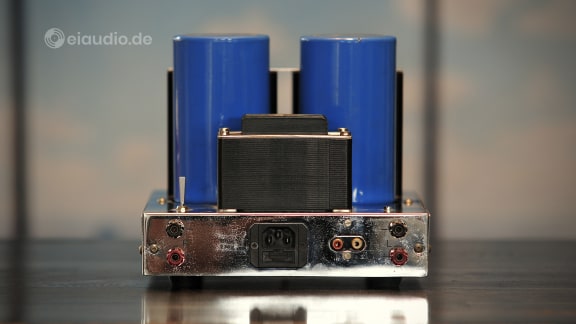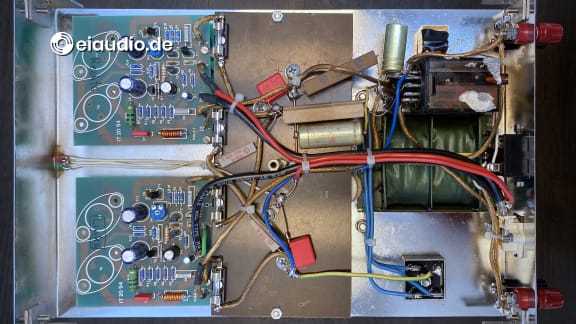Becker ST-200
Published: 20/03/2022
Manufacturing date: 1980
Author: Karsten Hein
Category: Gear & Review
Tag(s): Power Amplifiers
Having trodden down the path of audio exploration for a number of years, I could see myself growing increasingly bored with the black box designs that held the marvels of electronics. Especially the identical-looking folded metal covers that served to house all kinds of gear, ranging from exotic streamers to run-of-the-mill multi-channel amplifiers, stood for the sordid lack of devotion of an industry increasingly sidelined by more versatile and interactive technologies. To the audiophile listener, however, this meant a lamentable loss of variety and aesthetics. In the 21st century, the general rule was that all Hi-Fi devices looked the same, unless, of course, prospective customers were willing and able to shed a few month's salary on the purchase of a single unit.
Turntables and tube amplifiers were among the few Hi-Fi devices that had largely remained untouched by the folded-metal-covers-syndrome. On these exalted units it was still possible to see and appreciate the raw technology in action and to recognise a distinct design philosophy. And perhaps this was also part of the reason for their returning popularity among a fresh new generation of listeners. For the new spawning social media generation, daily survival was about gathering tangible experiences and developing a unique and marketable personal image. Recognisable product features were an important means to underscoring and fulfilling that personal mission. Exquisite designs and mature personalities both needed to strike the fine balance between boldness and compromise.
I suspect that this longing for truth in character was also the reason why I was attracted to the Becker ST-200 amplifier in the first place: The possibility of seeing its electronics and the stunning simplicity of its design. At the time of purchasing the amplifier, I did not have any information about its specifications nor had I heard of the brand. Nevertheless, I suspected that the ST-200’s attractive features would also be supported by the choice of electronics inside. Was this a limited series amplifier perhaps, or a DIY kit similar to the Hafler and Heathkit amps? I really could not tell from looking at the amp from the outside, and my enquiries in the usual Hi-Fi forums remained without a useful lead.
I decided to play detective myself. Searching the Internet for clues, I found that the Becker ST-200 used four Hitachi J49 power MOSFET transistors, i.e., two J49 transistors per channel. With each transistor fastened to its dedicated heat sink, there was little need to worry about overheating. MOSFET transistors were silicone-based solid state devices that could run quite hot, especially if set at a high class-A level. They were said to offer tube-like performance in the sense that they produced a warmer and less technical sound. Such characteristics were usually given preference by audiophile listeners over regular transistors. I learned that one pair of these Hitachi MOSFETs per channel was capable of delivering 100 watts of output. If fully exploited, this would make the Becker a 100 watts RMS per channel amplifier into an 8 Ohm load. Not bad at all, given its relatively compact size and moderate weight.
Following the MOSFET transistors, the Coke-can-like blue capacitors attracted my attention. Rated at 61,000pF each, these powerful capacitors were able to store enough energy to offer strong peak power and drive even the most demanding speaker loads. Unfortunately, the same could not be said for the transformer that looked to be of rather moderate size, especially when considering the amplifier’s available power. Our Hafler XL-280, by comparison, housed a transformer that was at least double the size and weight. After switching on, the Becker's transformer rattled for a short while, until a relay switched the amplifier boards on in order to let the music play. Before connecting the speakers, I opened the amp to make sure that no parts had gone missing or come loose on the inside. What I found looking under the hood surprised me a little: The quality components that were on display on the outside did not seem to be matched on the inside. The amp's wiring actually seemed somewhat improvised.
I would have liked to see twisted and tinned Belden 9497 wiring leading to the speaker binding posts. Instead, I found the typical multi-stranded copper speaker cables that were household standard during the 1980s. I also observed that signal and power cables were at times laid out in close proximity to each other or even touching. This naturally had the potential of compromising the amp’s signal output integrity. To protect our speakers from an unnoticed malfunction, such as direct current output, I first measured the signal output using a multimeter. I found that the amp churned out up to 20 volts playing from a direct CD source and measured the amount of DC voltage to be zero. All the more, I was surprised that connecting our loudspeakers revealed 50HZ noise on both channels, as well as some nasty current-failing distortion during playback. It seemed that some relevant parts of the amp needed replacement, and I initially had a feeling that this just might be the large capacitors.
In my efforts to find the original designer of the amp, I had contacted Helmut Becker of AudioValve who, by his own descriptions, was known to have experimented with a wide range of design concepts before finally settling on tube amplifiers. Sadly, I learned that the owner of AudioValve had passed away in the week before my enquiry, so that my question could neither be negated nor confirmed by the company’s helpful customer service personnel. Considering the impact of AudioValve on High End tube designs, I will leave it up to the readers of this article to decide how plausible they deem the connection. In the written words of the friendly customer service agent: "Möglich wäre es."
I wanted to learn more about the exposed Bauhaus-style amp and consequently took the Becker ST-200 to be serviced by our trusted technician. By this time, I had already gathered enough items on my list of electronic bugs to justify a full service. However, to my surprise, I was handed back the amp just three days later and informed that no parts needed replacing. "These are some formidable components that have been very poorly assembled" was our technician's verdict. He had therefore repaired only the most obvious blunders and handed the amp back to me so that I had the chance to listen and decide for myself if further repairs would be worth the effort and cost.
Back in our listening room, I connected the Becker ST-200 to our Tannoy system that was controlled by a Dynaco PAS-4 tube preamplifier. After a few minutes of warming up, the music sounded huge with great tonality but also an audible noise floor in addition to the humming transformer of the amplifier. I was sure this could be done better and replaced the Dynaco with our dead-silent Restek V1 preamplifier. The noise floor dropped considerably, and even the humming transformer subsided with each hour of playing music. What I was left with sounded like pure magic to my ears. This amp produced the most naturally pleasing soundstage that I had heard on our Tannoys thus far. In combination with our affordable Belden 9497 speaker wires, the result even came close to the tonal and spacial realism I had felt when listening to the H&S Exceptional amplifier playing on the HMS Gran Finale speaker wires. In theory, there should have been no comparison at all, given the difference in price, quality, and effort.
However poorly assembled the Becker ST-200 may have been, it was certainly able to cause quite a stir with audiophile listeners like myself, simply because it was capable of reproducing that Jazz club feeling: The groovy stomping, the spacial accuracy of width and depth of the venue, the tonal appeal of real wood and metal, and even the lush and magnificent lead vocals in the stage centre. What had first looked like a promising DIY job gone south managed to produce more musical realism than some of our ultra-accurate amp classics such as the Hafler XL280. And while the Becker's specifications perhaps did not amount to much on paper, the amplifier certainly managed to capture our attention us in our listening room. I was reminded of amplifiers like the Dynaco ST-70 that, too, was capable of bringing the Jazz club atmosphere home. Therefore, when continuing our full refurbishment of the ST-200 amplifier in order to eliminate the remaining humming, we needed to pay special attention not to destroy its inherent magic.
[At the time of writing this, the ST-200 still suffers from repeated crackling and sporadic signal loss on either channel during passages of low input signal, especially coming from phono.]
(To be continued…)
Specifications
- Type: MOSFET power amplifier
- Power rating: 100 WPC (8 Ohms)
- Transistors: 4x Hitachi MOSFET J49
- Housing: 2x chromed metal sheets
- Dimensions: (W)220mm, (H)190mm, (D)345mm
- Weight without power cable: 9.5 kg
- Country of manufacture: Germany
- Year(s): 1980 (estimate)






